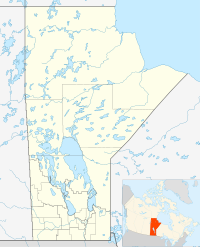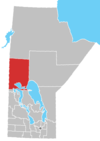| Misipawistik Cree Nation | |
|---|---|
 Grand Rapids in 1921 Grand Rapids in 1921 | |
 | |
| Coordinates: 53°09′36″N 99°14′01″W / 53.16000°N 99.23361°W / 53.16000; -99.23361 | |
| Country | |
| Province | |
| Government | |
| • Federal riding | Churchill |
| • Prov. riding | Swan River |
| Area | |
| • Total | 16.97 km (6.55 sq mi) |
| Population | |
| • Total | 716 |
| • Density | 42.2/km (109/sq mi) |
| Time zone | UTC-6 (CST) |
| Postal Code | R0C 1E0 |
| Area code | 204 |
| Misipawistik Cree Nation | |
| People | Swampy Cree |
| Treaty | Treaty 5 |
| Headquarters | Grand Rapids, Manitoba |
| Government | |
| Chief | Heidi Cook |
| Council |
|
| Website | |
| misipawistik | |
Misipawistik Cree Nation (MCN; formerly Grand Rapids First Nation, Cree: ᒥᓯ ᐹᐏᐢᑎᐠ misi-pâwistik, meaning: at the big rapids) is a Cree community in northern Manitoba. Misipawistik in the local Cree language means 'Rushing Rapids', which was once a historical Canadian landmark before the construction of the Manitoba Hydro-electric Dam in the late 1950s.
MCN is located near Grand Rapids, Manitoba, 400 kilometres north of Winnipeg, Manitoba, and is accessible via PTH 6. It is situated at the mouth of the Saskatchewan River as it runs into Lake Winnipeg. Misipawistik Cree Nation has one reserve (Grand Rapids 33) with an area of 1852.30 hectares and is governed by a chief and three councillors. The current Chief is Heidi Cook. It is a member of the Swampy Cree Tribal Council with offices in The Pas.
History
MCN is a Cree-speaking community in Northern Manitoba, Canada. The people of Misipawistik are largely ancestral descendants of indigenous Cree peoples who have populated the Canadian Shield region of northern and central Canada for 10,000 to 35,000 years. Cree peoples had been migrating to the area during the summer seasons for thousands of years prior to establishing a year-round settlement with the advent of the North American fur trade. Cree and Mixed families would continue to follow their seasonal cycles well into the latter half of the 20th century.
Many famous Canadian figures would pass through Misipawistik on the way through to Western Canada as transportation at the time relied heavily on waterways prior to the late 1800s. Notably, Pierre La Vérendrye would travel through and open up Fort Bourbon in 1741. By the late 1700s, Misipawistik would already be fully immersed in the North American Fur Trade. The area was considered a crucial point in the Fur Trade endeavour as most water-bound routes into the Northwest converged at this site. It was during this era that Misipawistik would become a year-round settlement for both Cree and Métis families as the Fur Trade would provide the economic means for some families to reside in the area year-round.
During the 19th century, the Fur Trade would start to dwindle while other economic activities would begin to emerge. Fishing and trapping started to represent how families would sustain themselves economically and this would continue well into the 20th century.
Treaty 5 Adhesion
The Cree people of Misipawistik had signed Treaty 5 in September 1875. According to Alexander Morris, the rationale behind the negotiation was due in part because of improvements in boating technology, but also because of the economic necessity of the region. As he would state in his self-written book, The Treaties of Canada with the Indians of Manitoba and the North-west Territories: "The progress of navigation by steamer on Lake Winnipeg, the establishment of Missions and of saw milling enterprises, the discovery of minerals on the shores and vicinity of the lake as well as migration of the Norway House Indians."
Initially, the Cree people negotiating an adhesion to Treaty 5 wished to have their reserve lands cover both sides of the Saskatchewan River entering into the Lake Winnipeg, but were nonetheless convinced to accept the Southern shore. The reason is still unclear as to how these negotiations played out.
National Cree Gathering 2007
Misipawistik Cree Nation hosted the 12th annual National Cree Gathering, a week-long event where Cree people from all over Canada and the United States came together to promote, preserve, and proclaim their traditional ceremonial practices, their distinct languages, and their ways of life.
A central component of the National Cree Gathering is the 'Unity Run' which involves youth from multiple participating communities. These youth run the journey from the previous hosting community to the next hosting community. In certain years, this journey can encompass over 2000 kilometres. This year, the youth will be running from Moose Factory, Ontario to Misipawistik Cree Nation.
Demographics
With a population of approximately 716 members, Misipawistik is a small community compared to the average First Nations community. The population consists of Cree, Metis people, and other First Nations people. Cree, and English are the two languages most widely used.
Notable members
- Ovide Mercredi
- Dr. Marlyn Cook
- Darla Contois, writer, actress
References
- "Tansi! Welcome to Misipawistik Cree Nation".
- ^ "2011 Community Profiles". Statistics Canada. Government of Canada. Archived from the original on 2018-12-26. Retrieved 2014-04-03.
- Ogg, Arden (August 19 2015) Cree Names of Cree-speaking Communities across Canada Link
- "Manitoba Historical Society (Thundering Waters Stilled: The Grand Rapids of the Saskatchewan by Martha McCarthy)". 1988. Retrieved 2014-03-04.
- "AANDC (Misipawistik Cree Nation)". Crown–Indigenous Relations and Northern Affairs Canada. Government of Canada. Retrieved 2014-04-03.
- Peter Kulchyski and Ramona Neckoway, The town that lost its name: the impact of hydroelectric development on Grand Rapids, Manitoba (Winnipeg: Canadian Centre for Policy Alternatives, August 2006) 20 pages. ISBN 0-88627-504-0
Tough, Frank. ‘As Their Natural Resources Fail’: Native Peoples and the Economic History of Northern Manitoba, 1870-1930. Vancouver, British Columbia: University of British Columbia Press, 1996.
External links
- Misipawistik Cree Nation Website
- AANDC profile
- Website for the 12th Annual National Cree Gathering
- Map of Grand Rapids 33 at Statcan
| Division No. 21, Manitoba (Flin Flon and North West) | ||
|---|---|---|
| Cities |
|  |
| Towns | ||
| Rural municipalities | ||
| First Nations | ||
| Indian reserves | ||
| Unorganized areas | ||
| Unincorporated communities | ||